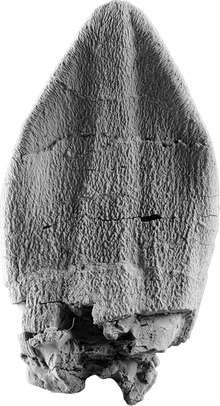Moabosaurus
| Moabosaurus Temporal range: Aptian, 125 Ma | |
|---|---|
 | |
| Skeletal mount with skull based on Camarasaurus | |
| Scientific classification | |
| Kingdom: | Animalia |
| Phylum: | Chordata |
| Clade: | Dinosauria |
| Order: | Saurischia |
| Suborder: | †Sauropodomorpha |
| Clade: | †Sauropoda |
| Clade: | †Titanosauriformes |
| Genus: | †Moabosaurus Britt et al., 2017 |
| Type species | |
| Moabosaurus utahensis Britt et al., 2017 | |
Moabosaurus (meaning "Moab reptile") is a genus of titanosauriform sauropod dinosaur from the Early Cretaceous Cedar Mountain Formation of Utah, United States.[1]
Description


Moabosaurus is characterized by a suite of features including: extremely low neural spines that are thin, transverse ridges in the posterior cervical vertebrae and anterior dorsal vertebrae; strongly procoelous proximal and distal caudal vertebrae; and an ulna with well-developed lateral and medial anteroproximal ridges combined with a large olecranon process.[1]
Discovery and naming
Moabosaurus was collected from the Dalton Wells Quarry, which is about 20 km northwest of Moab, Utah. The quarry produced parts of at least 18 individuals of Moabosaurus based on the number of braincases present, totalling over 5,500 bones.[1] Many of the recovered bones are fragmentary due to intense trampling as evidenced by breakage and trample scratches.[2] Another factor that degraded the bones before burial was consumption by insects. Insects, probably beetle larvae, consumed portions of the bones that were in contact with the ground, as evidenced by burrows and mandible marks.[2] Later, the bones were transported a short distance by a stream and buried in sediments reworked from the underlying Morrison Formation.[3] Detrital zircon crystals from the Dalton Wells Quarry yield an age of 125 million years, indicating Moabosaurus is Aptian in age.[3]
Classification
Phylogenetic analyses indicate Moabosaurus is a basal titanosauriform macronarian neosauropod. Unlike other titanosauriform sauropods it has thick-walled vertebrae with large pneumatic chambers (camerate-grade) as in basal macronarians and large, spatulate teeth, as in Camarasaurus. It appears to be closely allied with Turiasaurus, with which it shares derived features of the braincase; bifurcated cervical (neck) ribs; extremely low neural spines on the cervical and anterior dorsal vertebrae; and strongly procoelous proximal caudal vertebrae.[1]
Paleoecology
The Dalton Wells quarry has also yielded specimens of Venenosaurus (a brachiosaurid sauropod), the theropod dinosaurs Utahraptor and Nedcolbertia, plus a tall-spined iguanodontian,[4] and the ankylosaurian Gastonia. Non-dinosaurian taxa are rare at the quarry and are limited to fragments of a pterosaur, crocodilian, turtle, and a neochoristodere.[5]
References
- 1 2 3 4 Britt, B.B.; Scheetz, R.D.; Whiting, M.F.; Wilhite, D.R. (2017). "Moabosaurus utahensis, n. gen., n. sp., A New Sauropod From The Early Cretaceous (Aptian) of North America". Contributions from the Museum of Paleontology, University of Michigan. 32 (11): 189–243.
- 1 2 Britt, B.B., Eberth, D.A., Scheetz, R.D., Greenhalgh, B.W., Stadtman, K.L., 2009. Taphonomy of debris-flow hosted dinosaur bonebeds at Dalton Wells, Utah (Lower Cretaceous, Cedar Mountain Formation, USA). Palaeogeography, Palaeoclimatology, Palaeoecology. 280(1-2):1-22.
- 1 2 Eberth, D.A., Britt, B.B., Scheetz, R.D., Stadtman, K.L., and Brinkman, D.B., 2006. Dalton Wells: Geology and significance of debris-flow-hosted dinosaur bonebeds (Cedar Mountain Formation, eastern Utah, USA). Palaeoclimatology, Palaeoecology, Palaeoclimatology, 236:217-245.
- ↑ Scheetz, R., B. Britt, and J. Higgerson. 2010. A large, tall-spined iguanodontid dinosaur from the Early Cretaceous (Early Albian) basal Cedar Mountain Formation of Utah. Journal of Vertebrate Paleontology. Society of Vertebrate Paleontology Program and Abstracts Book, 28(3): 158A.
- ↑ Britt, B.B., R. D. Scheetz, D. B. Brinkman, and D. A. Eberth. 2006. A Barremian neochoristodere from the Cedar Mountain Formation, Utah, USA. Journal of Vertebrate Paleontology, 26(4): 1005-1008.